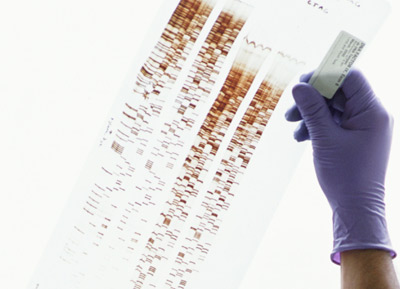Any type of organism can be identified by examination of DNA sequences unique to that species. However, identifying individuals within a species, such as individual humans, is currently a less precise science. Nonetheless, as DNA sequencing technologies progress further, direct comparison of very large DNA segments and possibly even whole genomes, becomes more and more feasible and will allow precise individual identification, a very useful tool in forensics. (46)
 Figure (48) | What is Forensics? Forensics, defined by dictionary terms, is the application of scientific practices within the legal process. (47) Because criminals often leave behind very little evidence, forensic scientists turn to evidence a little less apparent- DNA. Nowadays forensic science routinely uses DNA in complex serious offences, solving murder with the building blocks of life. (48) |
How do they use DNA?
Disputably the most significant advance in police work since fingerprinting, DNA profiling has only really been in general forensic use for the last two decades. At a crime scene, DNA is everywhere. It is present in all kinds of evidence collected at the scene, including blood, hair, skin, saliva and semen. Scientists can analyze the DNA in evidence samples to see if it matches a suspect's DNA. (50) PCR technology enables scientists to use the very small samples found at a crime scene to identify individuals. To do this, forensic scientists scan 13 DNA regions, or loci, that vary from person to person and use the data to create a DNA profile of that individual (sometimes called a DNA fingerprint). The chance that another person has the same DNA profile for a particular set of 13 regions is extremely small. The breakthrough of genetic sequencing was hugely important to the forensic field. Evidence and proof has become much more specific and the new technology has also helped crack cases that have been unsolved for years. Now, so-called ‘cold cases’ are being routinely reopened and investigated using modern forensic techniques – some dating back to the 1950s and beyond. (49)
 A scientist views an autoradiograph, which is one of the first methods of DNA profiling. Figure (51) | Timeline Before the era of DNA, blood typing was used as a form of evidence. The introduction of DNA sequencing to the forensics had a huge impact on the amount of evidence that can be used in criminal investigations. 1984- Alec Jeffrey of the University of Leicester introduces a technique for DNA finger-printing to identify individuals using RFLPs, enabling genetic fingerprinting to enter courtrooms the following year. (3) 1986- The first case of DNA being used to solve a crime (49) 1995- Applied Biosystems introduces systems that automate and standardize DNA-based technology for forensic investigation. • 1995- DNA finger printing using PCR becomes accepted in court as reliable forensic evidence and is brought to public attention in the O.J. Simpson trial (3) 2001- Applied Biosystems human identification technology is used to identify 9/11 World Trade Center victims (3) |